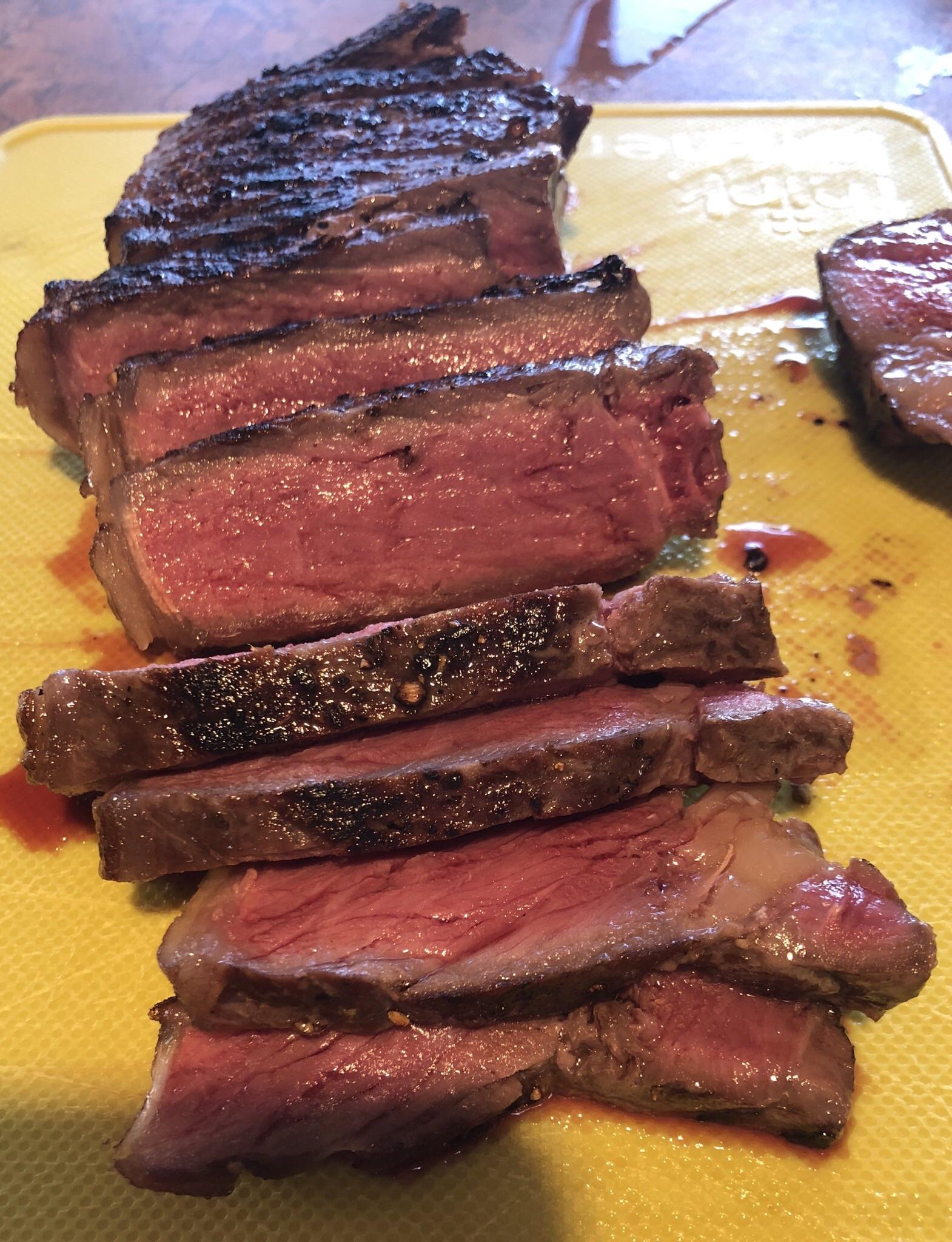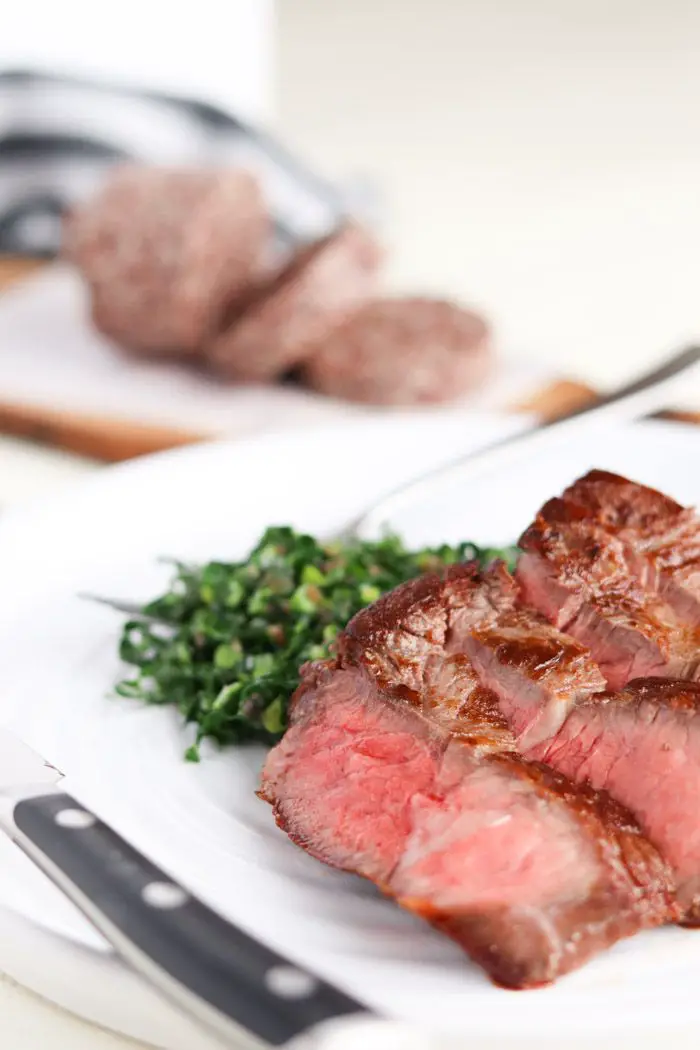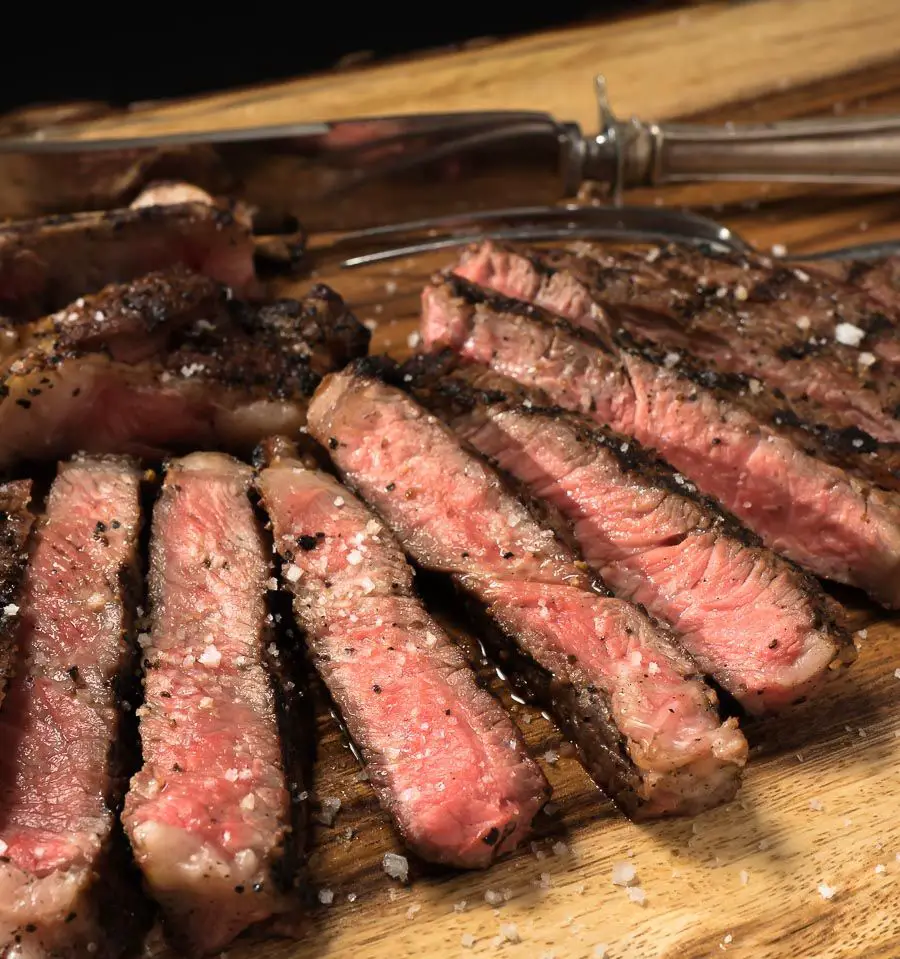How To Reverse Sear A Steak On The Grill
You can reverse sear a steak on the grill as well, instead of the oven. Heres how:
Cooking reverse sear steaks on the grill wont give them the same crust that a pan sear does, but theyll still be perfectly cooked.
My Honest Review Of J Kenji Lopez
This steak was incredible. The overnight dry-brine made for well-seasoned steak. The slow roast ensured the meat stayed tender and cooked evenly throughout. My steak was notably warm when I ate it because it didnt need to rest after the finishing sear. I can assure you, however, that the chilled leftovers were excellent the next day, even straight from the fridge.
This recipe supersedes every othersteak recipe Ive ever used. In my opinion, this is the new conventionalwisdom.
Hailed As The Ultimate Way To Cook A Perfect Medium
You may have heard of this reverse sear method. It might be the biggest thing to happen to steak since the discovery of the ribeye. The reason reverse sear has gathered SO much attention, is that its a near infallible way to cook a steak perfectly, every single time. It also works on larger pieces of red meat. Traditionally, a restaurant method of cooking steak involved searing over incredibly high heat, then transferring to an oven to finish on a more gentle heat until done. The reverse sear method pretty much just flips the order.
Also Check: The Great Steak And Potato
How To Reverse Sear
Start with any roast or steaks that are at least 1 1/2 inches thick. Preheat your oven to 275F. Line a sheet pan with parchment paper and place an oven-safe wire rack on top of the lined pan. Place the meat on the wire rack and season it with salt and pepper or your favorite spice rub. Place the whole thing in the oven and roast it until the interior is about 15 degrees below your desired final temperature anywhere from 30 to 50 minutes. Start checking the internal temperature with an instant-read thermometer after 15 minutes to get a sense of where you are in the process.
When the center reaches your target temperature, remove the meat from the oven. If you want, you can tent it and let it rest at room temperature for up to 90 minutes.
For steaks: Set a heavy bottom pancast iron is perfectover the highest heat you can muster. When the pan is smoking hot, add a touch of oil and lay in the steak. It should take only 1 to 2 minutes per side to get a nice sear.
For roasts: Crank the oven to its highest settingusually 500 to 550F. Place the roast in the oven until the outside is golden brown, about 10 to 15 minutes.
A note about times and temperatures: Remember, all equipment is different. Different ovens have different hot and cool spots. Different pans conduct heat differently. Thus, never expect perfection your first time out. Get to know the process, learn from your experiences, and make adjustments to your method.
The Best Inexpensive Thermometer: The Thermopop

This has been my favorite inexpensive thermometer ever since it was introduced a couple of years ago. It was the new standard then, and it remains the best-in-class now. It’s rated to give readings in five to six seconds, but it typically clocks in at under threenearly as fast as its big brother, the Thermapen. The dial is large and easy to read and is backlit for extra visibility when you’re grilling at night or reaching into a dark oven. The display also rotates in 90° increments with a simple push of a button, which facilitates reading at even the most awkward of angles.
The Thermopop also comes in a variety of bright colors, if you care about such things, and has a nice long probe that can reach into the center of even the largest roast.
Don’t Miss: How To Barbecue The Perfect Steak
Disadvantages Of The Reverse Sear Method
The reverse sear method is great for many of the most popular, thicker steak cuts, but its not the right choice for all steaks. One of the biggest disadvantages of the reverse sear is that it isnt a good option for thin steaks. Thin steaks often cook so quickly, regardless of what method you use, that trying a reverse sear might actually lead to an overcooked steak.
Another disadvantage is that this method can take a little more time to sear steak. If youre short on time or just want the quickest cook possible, sticking your steak on a cast iron pan or the grill and searing it can be quicker. However, if you have a thick cut that will need a few minutes in the oven anyway after you sear it, the timing will be about the same.
Finally, a pan sauce isnt as easy to make with reverse sear. Unlike regular searing, reverse sear wont leave behind those yummy brown and crispy bits in your pan that are often used to make a pan sauce with butter and spices.
How To Reheat Reverse Seared Steak
Because the reverse sear steak has already reached its proper temperature, youll want to carefully reheat your steak.
My family actually was unable to finish the 4 gorgeous steaks shown in the post on the day I made them, so I did test reheating, and was very impressed that the reverse sear steak was juicy even up to a week later!
Here is the best method to reheat reverse seared steaks:
- Preheat the oven to a low temperature, such as 250 or 300 degrees F.
- Place the steaks in a baking dish and add a little broth to the bottom . Seal the top with foil.
- Heat in the oven for about 10 minutes, or until warm.
You May Like: Steak And Shake Kids Meal
Does The Reverse Sear Method Change For Different Cuts
This method wont change much for most cuts other than filet mignon or ribeye. The only thing youll have to play around with is the amount of time you keep your steaks in the oven and the amount of time each side needs to brown in the skillet. The thicker the steaks, the longer it will take in the oven to reach the proper internal temperature.
Invest In A Good Grill Thermometer
I cant stress the importance of this enough. Getting the internal temperature of your meat right isnt just important for the sake of ensuring good flavor, but also food safety. In-built thermometers in grills tend to be cheap and unreliable, so I suggest buying your own.
If youre not sure where to start then check out grill thermometer reviews guide for some affordable and solid options. Now on with the recipe!
Read Also: Wusthof Serrated Steak Knife Set
Why Reverse Sear A Steak
There are many benefits to reverse pan sear steaks:
- Steaks are cooked evenly throughout, instead of having steaks be overcooked in some areas
- Prevents the dreaded gray edge with an even internal pink color
- More tender, super juicy meat thanks to the low-temperature, slow cooking method in the oven
- Better browning on the outside
Why Should You Sear Meat
The reasons for searing are many:
A golden-brown crust on a steak or roast looks more appealing than a damp, gray exterior.
The toothsome texture of that crust provides a delightful contrast to the creamy tenderness of the interior.
The crusts flavor is decidedly different from that of the interior, offering a salty, charred taste that contrasts the sweeter interior meat.
The rich aromas of searing meat draw us to the table and make our mouths wateran important physiological reaction called trigeminal response. This makes us experience the meat as juicier and also aids in digestion.
One thing searing does not do is seal in the juices. Mythical poppycock notwithstanding, the previously mentioned actual results of searing make it more than a worthwhile endeavor.
Also Check: Omaha Steaks Dry Ice Disposal
How Is Reverse Sear Steak Different From Sous Vide Steak
Reverse searing often gets compared with the sous vide process of cooking a ribeye steak or another steak cut. While the idea is the same more even cooking its not the same method and doesnt produce the same finished product.
Sous vide steak gets cooked in an airtight bag thats placed in temperature-controlled water. The water helps the meat reach the proper temperature throughout, yet doesnt dry it out at all because the water never touches the steak.
The reverse sear method is also used to achieve a more consistent cook, but its also designed to dry the steak out somewhat, allowing for that rich, crispy sear on the outside. Sous vide steak is usually left as-is after cooking rather than seared. Once a reverse sear steak gets cooked to the proper internal temperature, you sear it to get a browned crust.
How To Reverse Sear Steak

Step 1:
Whether you are going to grill ribeyes or any other thick steak, seasoning is your introduction. Season it uniformly over all sides using pepper and salt.
Then, you can now place on a wire rack which you have set in a rimmed baking sheet. In case youre using the grill, you can skip the rack and pan. To invite better results, we advice refrigerating uncovered steaks overnight. In effect, this dries out the exteriors.
Step 2:
Start by preheating your oven to any temperature ranging between 200 and 275 degrees F. Though rare, if your oven can hold temperatures below 200 degrees F, it can be better. Theres a paradox here. The lower you go, the more even your meat is likely to cook. But at the same time, the lower you go, the longer you will spend cooking.
So, its you to determine if you want to have the best or have whatever you may have quickly. Definitely, quick results without quality end up in long-term frustrations. Better set it low and be patient to obtain the ultimate desires of your heart.
Once youve set your BBQ in the outdoors, simply create a two-zone fire by banking a coal chimney under one side of your grill. Alternatively, you can simply turn on only half of your grill burners. Cover it up and allow for optimal pre-heating.
Step 3:
Place your steaks in the oven and roast to a temperature of 10 to 15 degrees F below your preferred final serving temperature. You can use an accurate remote thermometer to monitor the temperature progress.
Step 4:
Step 5:
Don’t Miss: Pizza Hut Philly Cheese Steak Pizza
You Can Use Any Apparatus For Reverse Searing As Long As Its Low Heat Then High Heat
Thats right. Reverse sear is the technique, NOT the equipment. As long you as you apply low heat for the majority of the cook, then finish with high heat, thats reverse searing. So, the low heat could be from a smoker, indirect grill, low oven or sous vide. And the high heat could be from a hot cast iron pan, blazing charcoal or a 500f oven. As long as you pair one with the other, you can reverse sear.
The Best Guide On How To Reverse Sear Steak
A reverse steak is the best way of cooking a steak. This is not just a mere adage, but an honest ascertain full of truth. In simple terms, this is the technique of slow-cooking or roasting a steak at first and then finishing it off with a hot sear. Contrary to the traditional cooking guide which assumes that searing helps to retain the juices, searing only adds flavor.
Now, assuming it comes at the end instead of it taking place at the beginning? It works out so perfectly to increase the flavor of your delicacy. This is where we hinge our idea of reversing the sear rather than bringing it at the initial phases of cooking.
More…
In fact, advantages of reversing the sear goes beyond merely obtaining an excellent flavor. It goes to an extent of giving you a tender, browned and evenly cooked meat. Lets look into the steps of reversing the sear because its needless to say youre going to need this process sooner or later.
Also Check: Charleys Philly Steaks Corporate Office
How To Reverse Sear Ribeye Steak
Heres how to reverse sear ribeye or your other favorite thick cuts using your oven, a warmed-up skillet on the stove, and some salt and pepper:
You can use a similar method on the grill too. Cook the steaks over low heat until theyre about 10-degrees below your optimal cooking temperature. Then move them over to the side with high heat and give them a good sear on each side.
How Does Reverse Sear Method Work
The basic idea is that with reverse sear, you can have extreme control over the doneness of your steak, achieving a perfect edge to edge medium rare without any gray or overcooked gradient. It works because youre using low heat to cook the meat gently, then giving it a very brief HOT sear at the end, so the inside ends up perfect. So really, reverse sear is cooking via LOW heat, and then briefly applying HIGH heat to finish.
Read Also: How Do You Cook Steak
Cook The Steak In The Oven
When cooking the steak in the oven, use an instant-read meat thermometer to check the internal temperature of the thickest part of the steak. Once 15 minutes passes, check the temperature and continue checking every 5 minutes until you hit:
- 90 to 95ºF for medium-rare
- 100 to 105ºF for medium
The steaks will finish cooking in the skillet and continue to increase in temperature, so you dont want to cook the steak in the oven completely.
The Method And Why Its So Great:
I absolutely love preparing steaks this way. Its so easy! I have a few reasons why the reverse sear method is my favorite:
- Cooking the steak in a low-temp oven removes a lot of moisture from the surface of the steak, meaning youll be able to get a beautiful crust when you sear it later.
- The low, even heat means youll have more control over the final temperature. Its very similar to the concept of sous vide cooking without the expensive equipment.
- Youll have nearly edge-to-edge pink, without any gray rings
So thats why reverse searing is amazing, but here are two unexpected results of the method that I love:
- While the steak is cooking in the oven, you can get the rest of your dinner prepared without worrying about overcooking the steak.
- Second, you rest before you sear which means you get to slice the steak and serve immediately when its piping hot but perfectly rare or medium-rare.
You May Like: Omaha Steaks Filet Mignon Recipe
What Kind Of Steaks Should I Use For Reverse Sear
Reverse searing is not meant for thin sticks or steaks that cook relatively quickly, such as skirt steak or filet mignon.
Opt for this method when you have a big hunk of steak like a big NY strip or ribeye or large sirloin steak.
This method really works best when your steak is at least one poundand at least 1½ inches thick.
Wait Wont I Just End Up With Gray Steak

No, surprisingly not! The steak is cooked at such a low temperature that YES, it will be gray on the outside but the inside will be whatever internal temperature you cook it to. Its super important to have a meat thermometer to track your internal temperature.
If you can get a meat thermometer that you live in for the entire time, thats ideal. My favorite is the ThermoPro because I can pop the thermometer on the stove and it will ding when it reaches my desired internal temperature.
Also Check: Gas Grill New York Strip Steak
How To Reverse Sear Tomahawk Steak
Because its a large cut of meat, a lot of people prefer to oven roast Tomahawks. I prefer to grill it however, so today Im going to show you how to cook it over a charcoal grill.
Like with any meat, internal temperature is key so youll need a good meat thermometer. Youll be aiming for an internal temperature of 140°F to achieve a medium-rare level of doneness.
Reverse searing is a bit easier to do in an oven or gas grill because of the easier use of temperature control you get. Charcoal grills are more of a challenge, but if you know how to regulate temperature with your grills vents and you know how to use indirect grilling then you should get the hang of it pretty quickly.
If youre using a gas grill then you might find that your grill is limited in terms of its maximum temperatures. However if your grill has at least two burners then you should be fine.
Pro Tip: If your gas grill is limited with its maximum temperatures then I recommend transferring your steak to a griddle pan for the searing part of the cooking. Place steak directly onto the scorching hot cast iron, flipping every 45 seconds. Do this for about 5 minutes or until desired level of dark crust develops.
